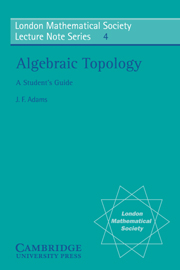Book contents
- Frontmatter
- Contents
- INTRODUCTION
- PAPERS ON ALGEBRAIC TOPOLOGY
- 1 Combinatorial homotopy
- 2 An axiomatic approach to homology theory
- 3 La suite spectrale. 1: Construction générale
- 4 Exact couples in algebraic topology
- 5 The cohomology of classifying spaces of H-spaces
- 6 Cohomologie modulo 2 des complexes d'Eilenberg-MacLane
- 7 On the triad connectivity theorem
- 8 On the Freudenthal theorems
- 9 The suspension triad of a sphere
- 10 On the construction FK
- 11 On Chern characters and the structure of the unitary group
- 12 Espaces fibrés et groupes d'homotopie. I, II
- 13 Generalised homology and cohomology theories
- 14 Relations between ordinary and extraordinary homology
- 15 On axiomatic homology theory
- 16 Characters and cohomology of finite groups
- 17 Extract from thesis
- 18 Relations between cohomology theories
- 19 Vector bundles and homogeneous spaces
- 20 Lectures on K-theory
- 21 Vector fields on spheres
- 22 On the groups J(X). IV
- 23 Summary on complex cobordism
23 - Summary on complex cobordism
Published online by Cambridge University Press: 23 May 2010
- Frontmatter
- Contents
- INTRODUCTION
- PAPERS ON ALGEBRAIC TOPOLOGY
- 1 Combinatorial homotopy
- 2 An axiomatic approach to homology theory
- 3 La suite spectrale. 1: Construction générale
- 4 Exact couples in algebraic topology
- 5 The cohomology of classifying spaces of H-spaces
- 6 Cohomologie modulo 2 des complexes d'Eilenberg-MacLane
- 7 On the triad connectivity theorem
- 8 On the Freudenthal theorems
- 9 The suspension triad of a sphere
- 10 On the construction FK
- 11 On Chern characters and the structure of the unitary group
- 12 Espaces fibrés et groupes d'homotopie. I, II
- 13 Generalised homology and cohomology theories
- 14 Relations between ordinary and extraordinary homology
- 15 On axiomatic homology theory
- 16 Characters and cohomology of finite groups
- 17 Extract from thesis
- 18 Relations between cohomology theories
- 19 Vector bundles and homogeneous spaces
- 20 Lectures on K-theory
- 21 Vector fields on spheres
- 22 On the groups J(X). IV
- 23 Summary on complex cobordism
Summary
The next piece is a summary on complex cobordism, written by me especially for the present work.
The subject of complex cobordism has two aspects: a geometrical side, on which it links up with the theory of complex manifolds, and a hornotopy-theoretic side, on which it links up with generalised homology and cohomology theories and the study of spectra. I begin by sketching this. (Afterwards I will present the calculation of π(MU), and finish by sketching some topics from the further development of the subject.)
Let Mm1 and Mm2 be two smooth manifolds, of dimension m, compact, without boundary and both of the same sort: that is, both non-oriented, or both oriented, or both with whatever extra structure is to be considered. Then we say that Mm1 and Mm2 are cobordant if there is a smooth manifold Wm+1 of dimension m + 1, compact, with boundary, and of the same sort, such that the boundary of Wm+1 is the disjoint union of Mm1 and Mm2.
Here the notion of ‘boundary’ is taken in the sense appropriate to manifolds of the sort considered, so that we include a condition on any extra structure we may have. For example, if we are working with oriented manifolds, then we ask that the boundary of the orientation class on Wm+1 should be plus the orientation class on Mm2, minus the orientation class on Mm1. Similarly for other forms of extra structure. Cobordism is an equivalence relation, and divides m-manifolds of the sort considered into equivalence classes.
- Type
- Chapter
- Information
- Algebraic TopologyA Student's Guide, pp. 260 - 273Publisher: Cambridge University PressPrint publication year: 1972



